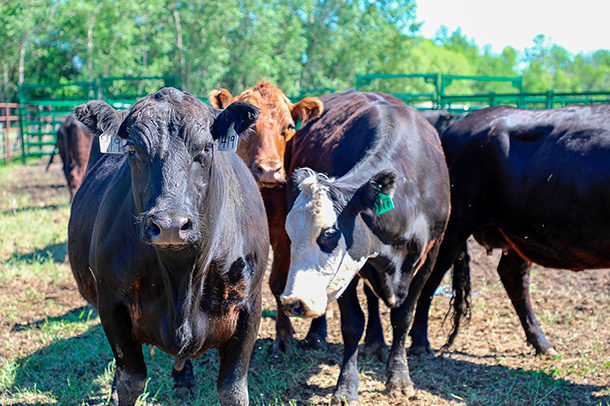Extreme heat and humidity make for dangerous situations on cattle operations and can cause heat stress, cattle sickness and even death, in extreme cases. Heat management in your cattle operation should always remain a top concern.
There are many tips and tricks for working in the heat and during extreme weather events to mitigate heat stress in cattle and lead to better outcomes for all.
More-favorable weather conditions can improve cattle -handling efficiency and creature comfort, but less-intense weather can still negatively impact cattle health and the economic viability of your operation when temperatures suddenly spike. As a good practice, before working cattle in the summer months, think about low-stress cattle handling and adequate management systems that can help mitigate the effects of adverse weather conditions.
First, it is important to understand a few facts about cattle and why proper heat management is so important.
- Cattle are more susceptible to heat stress than humans are. The ideal temperature range for cattle is between 32ºF and 75ºF.
- Cattle cannot recover from the previous day’s heat stress if the temperature stays over 70ºF at night.
- Cattle suffer from heat stress any time the temperature-humidity index (THI) is 80ºF or higher. It does not take much to hit that number.
Knowing this, cattle handlers can take a proactive approach to heat management that includes using their cattle-working system effectively and providing additional care for animals.
Heat management is important for both handlers and animals. Most people are already aware of how to manage heat stress in themselves and employees, but it never hurts to review before working in extreme weather. Managing heat in cattle requires a multifaceted approach given their susceptibility to temperatures. Part of your approach should pertain to animal care, while the other focuses on cattle handling.
Animal care
Animal care is the first step in heat management because it improves the conditions that cattle are in while facing heat stress. There are several proactive steps you can take to help cattle.
1. Watch the weather. Know what you are up against well ahead of time. While weather reports frequently change, you should have a basic idea of what to expect two to three days in advance, providing adequate time to prepare.
2. Allow cattle more space. Separating cattle into smaller groups will reduce herd density and create less overall body heat and stress.
3. Give extra water. The amount of water cattle consume during high-heat events will double to around 30 gallons of water per animal per day. Add extra water tanks and refill them regularly with fresh, clean, cool water.
4. Provide shade. Shade or some sort of shelter where cattle can escape the direct sun has immediate benefits for them.
5. Add sprinkler systems or fans. Sprinkler systems or fans can be added to barns and feedlots to cool cattle down either through misting or increased airflow.
6. Remove manure. Keep pens and feed lots clean by removing manure. It creates extra humidity on top of attracting flies and other pests, furthering the effects of heat stress.
7. Feed in the evening. Cattle need constant access to feed. If your cattle aren’t in the pasture in the summer months, aim to provide the bulk of feed in the evening. This encourages cattle to eat overnight when the temperature is naturally lower.
Cattle handling
Cattle handling is an important part of heat management for all operations. Unfortunately, work sometimes must go on, despite elevated temperatures, but there are steps that can improve outcomes in these situations.
1. Always use low-stress cattle-handling principles. By now, most operations practice low-stress cattle-handling principles, which are even more imperative in extreme weather scenarios. Aim to also invest in cattle-handling equipment that works with cattle’s natural behavior by allowing them to see light and move in curves for a seamless working experience.
2. Work cattle early in the day. Any work done with cattle should be done first thing in the morning or later in the evening, avoiding the highest temperatures of the day, between the hours of 10 a.m. and 4 p.m.
3. Work smaller groups of cattle. Decreasing the number of cattle in a group being worked reduces the amount of time cattle are in the handling system and lowers the overall body heat of the herd. Animals should not be held in cattle-handling systems for any longer than 30 minutes.
4. Slow down. Going slow is already a principle of low-stress cattle handling. Slow it down even further during high heat.
5. Service equipment before working cattle. Take time to make sure everything on your cattle-handling equipment is working correctly before working cattle in hot weather. This is not a good time to have an equipment malfunction. If your equipment does require service, ensure you’re covered by working with a company that stands behind its products with a warranty and provides 24/7 customer service and reliably has parts in stock.
The best cattle heat stress management strategies are incorporated before high temperatures and humidity arrive. However, it’s never too late to implement some or all these steps on your operation to help cattle through the summer months. By considering the weather and temperature and planning before starting the day’s work, you are guaranteed more success.











